|

 Up
Up 
 Landing
Landing
Without
Crashing

(You are here.)



  Need
to Need
to
find your
bearings?
Try
these
navigation aids:
If
this is your first
visit, please stop by:
Something
to share?
Please:



|
|
Available in Française, Español, Português, Deutsch, Россию,
中文,
日本, and others.
 he
pioneer aviation era literally flew by, lasting just
a little more than a decade from the first wavering flights at Kitty
Hawk to the beginning of World War I. By this time "second
generation" aircraft had begun to emerge, combining both maneuverability
and stability. This rapid development is all the more remarkable
when you consider that for the first few years, the Wright brothers
were the only successful pioneers. A few visionaries in America and Europe made
brief hops in a handful of airplanes, but nothing approaching the
performance of the Wright Flyer in its final 1905 form. This despite the fact that
these builders had access to the Wrights' published patents. It
wasn't until the Wrights began demonstrating their airplane in 1908
that the rest of the world fully understood the necessity of
three-axis control and how to use it. he
pioneer aviation era literally flew by, lasting just
a little more than a decade from the first wavering flights at Kitty
Hawk to the beginning of World War I. By this time "second
generation" aircraft had begun to emerge, combining both maneuverability
and stability. This rapid development is all the more remarkable
when you consider that for the first few years, the Wright brothers
were the only successful pioneers. A few visionaries in America and Europe made
brief hops in a handful of airplanes, but nothing approaching the
performance of the Wright Flyer in its final 1905 form. This despite the fact that
these builders had access to the Wrights' published patents. It
wasn't until the Wrights began demonstrating their airplane in 1908
that the rest of the world fully understood the necessity of
three-axis control and how to use it.
From that moment,
aviation accelerated at an unprecedented rate – and for good reason.
Across the globe, politicians were struggling mightily to maintain
the "balance of power." Diplomacy had become a tangled web of
treaties promising mutual aid in the event of attack. Germany was
locked in an arms race with France and England. World war was
imminent and the airplane looked to be a versatile and deadly
weapon.
- Landing Without Crashing, 1903 to 1905
–
The Wright Brothers develop their temperamental Kitty Hawk Flyer into
a practical flying machine.
- Wake Up Call, 1905 to 1909
–
The Wright brothers accomplishments alert aeronautical
scientists and engineers in America and Europe to the
possibilities of fixed wing aviation.
-
Faster, Higher, Farther, 1909 to 1912
– Pilots and engineers
begin to explore the capabilities and push the possibilities of
aircraft.
- Girding for Battle, 1912 to 1914
– As the First World War
approaches, nations develop the airplane into a weapon.
|
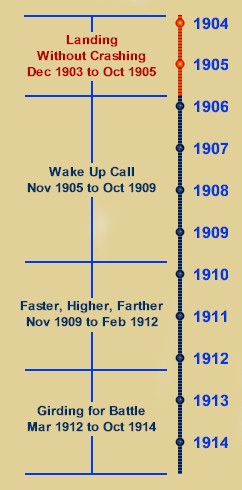
|
Time
|
Event
|
|
1903 |
December
— On the train ride from
Kitty Hawk to Dayton, the Wright brothers decide to
continue their aeronautical work until they have developed
their Flyer into a "practical" flying machine. Wilbur later
defines a practical flying machine as one that can take off
in a wide range of weather conditions, navigate to a
predetermined location, and "land without crashing."
|
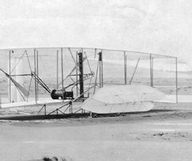
|
Although the Wrights made four successful flights on
December 17, 1903, the same cannot be said of their
landings. None of them were planned and the fourth and last
landing damaged the elevator.
|
|
1904 |
January 5
— Hoping to quash all the
fantastic rumors about their airplane, the Wrights
issue a statement to the Associated Press describing their
first powered flights at Kitty Hawk on December 17, 1903.
January 22 —
The Wrights engage attorney Harry A. Toulmin
of Springfield, Ohio to handle their patent applications.
March — Ernest
Archdeacon, France puts up a purse of 25,000 francs for the first officially
recorded circular flight of one kilometer, called the Grand Prix d’Aviation,
to be awarded by the Aéro-Club de France. French
oil magnate Henry Deutsch de la Meurthe matches Archdeacon, raising the
prize to 50,000 francs, or about $10,000.
March 22-24
—
Harry A. Toulmin
applies for the French and German patents on the Wright
airplane.
March-May
— The Wrights build a second
airplane, the Flyer II. It is a copy of their first
Flyer, but it has a more powerful motor (18 hp).
Spring Alberto Santos-Dumont, France, a
pilot famous for his pioneering work in dirigibles, begins to experiment with gliders.
April 1-15 —
Ernest Archdeacon tests a "type du Wright" glider
near Berck-sur-Mer, France, piloted by Ferdinand Ferber
and Gabriel Voison. Although the glider is based on
the 1902 Wright design, the wings are shorter, the camber
deeper, and there is no roll control. Archdeacon considers
its performance unsatisfactory.
May — Robert
Esnault-Pelterie, France, tests a type du Wright
glider, but he has trouble with the wing warping and
determines to improve it.
May 23-26 — The Wrights attempt to fly at Huffman
Prairie, near Dayton, Ohio before the press on two occasions with their new machine, the Flyer II.
But even with a more powerful motor, it can only manage brief hops. The
press is kind, but unimpressed.
July 1 — The first of the Wright’s
patents (French) is granted.
August 13 — Wilbur makes a flight of
1340 feet (408 meters) in the Flyer II, beating his performance in
Kitty Hawk for the first time. But the brothers are still have trouble getting into the air and staying there.
September 7 — The Wrights develop a catapult
launching system to get their aircraft up to flying speed. It works well, and they begin
to make progress again.
September 20 — Wilbur Wright flies the
first complete circle in an airplane. The flight is witnessed by Amos Root,
inventor of the modern bee hive and publisher of Gleanings in Bee Culture.
October —
Robert Esnault-Pelterie tests a rebuilt version of his
glider with primitive elevons mounted forward of the wings.
October —
Ferdinand Ferber rebuilds his glider with an elevator in
front and the fixed horizontal tailplane in back. He also
mounted to triangular wingtip rudders. While testing this
glider, he takes his mechanic, Marius Burdin, aloft for a
short flight, making him the first passenger in a
heavier-than-air machine.
October —
The Aéro-Club de France adds to their list of
prizes to encourage the development of aviation in France.
The Coupe Ernest Archdeacon consists of a trophy and
1500 francs. The trophy goes to the first aviator to fly 25
meters (82 feet) and the cash to the first to fly 100 meters
(328 feet). The Prix pour record de distance will
award a silver medal and 100 francs to the first 10 pilots
to fly 60 meters (197 feet) and 1500 francs for the first to
fly 100 meters. As aviation progresses, the Aero-Club
will offer additional prizes for flights of 150, 300, and
500 meters (492, 984, and 1640 feet).
October 15 —
Lt. Col. John E. Capper of the British Army visits to
Wrights in Dayton to obtain information on their airplane
and express an interest in buying it.
November 9 —
Wilbur flies for 5 minutes and 4 seconds, traveling
2-3/4 miles (4.4 kilometers) and completing 4 circles around
Huffman Prairie. It is the best flight of the season.
|
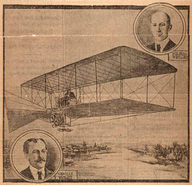
The fantastically inaccurate story that was fabricated for
the Virginia Pilot
newspaper was picked up by many other papers nationwide.
This appeared in the
Chicago Tribune.
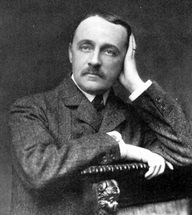
Ernest Archdeacon.
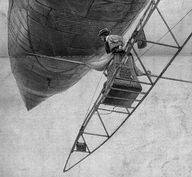
Santos Dumont flying his
No. 6 dirigible in Paris, France.
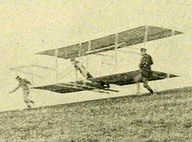
Esnault-Pelterie represented his first glider as an exact
copy of the Wrights' 1902 design, but like so many of his
French buddies, did not understand the purpose or the
mechanics of wing warping.
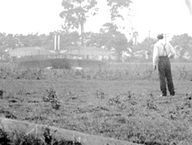
The soft soil at the prairie was a wise choice. A number
of the Wrights' flights ended like this one on 16
August 1904.
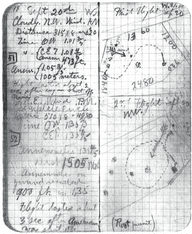
The pages from Wilbur's notebook that record the first circular flight.
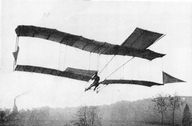
Ferber's 1904 glider design with an elevator in front and a
horizontal tail in back would have enormous influence of
later French designs.

Wilbur keeps the Flyer II
aloft for just over 5 minutes on 9 November 1904.
|
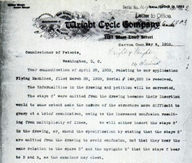
Until they engaged Harry Toulmin in 1904, the Wrights had
tried unsuccessfully to file their own patent, as this
letter indicates.

The patent drawings that Toulmin prepared show the 1902
glider, not the 1903 Flyer. Toulmin focused the patent
application on the Wrights' single most important
accomplishment – their control system.
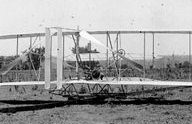
The Wrights realized that four flights in their first Flyer
didn't provide enough experience, so the Flyer II was a copy
of the first to allow them to thoroughly test the design.
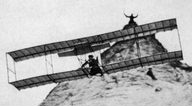
Voisin flies Archdeacon's glider at the sand dunes on the
French side of the English Channel.
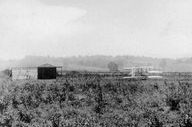
Huffman Prairie had been a failed peat bog. The "frost
heaves" every winter fluffed up the soil, making it very
soft.
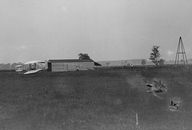
The Wright catapult consisted of a high derrick (right) that
dropped a heavy weight, pulling the Flyer along the launch
track.
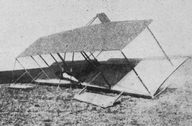
Having tried and discarded wing-warping, Esnault-Pelterie
reworked his glider with elevons or "little wings," as he
called them. These were the forerunners of ailerons.
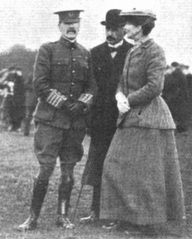
Lt. Col. John Capper (left), later Sir John Capper, was one
of the driving forces behind Britain's pioneer aviation
programs.
|
|
1905 |
January 1 — After
trying and failing to interest Scientific American,
Amos Root publishes an eyewitness account of the
Wrights' 20 September 1904 flight (the first circle ever
flown) in his own publication, Gleanings in Bee Culture.
January 3 —
Wilbur Wright meets with Ohio Congressman Robert M.
Nevin to discuss selling their airplane to the United
States military. Nevin suggests writing a letter which he
will hand-carry to President Taft.
January 18 —
Wilbur writes the letter requested by Nevin.
Owing to a miscommunication, the letter is forwarded to the
US Department of War. Nevin has no chance to present
the Wright's proposal in person to the President.
January 26 —
Nevin's office forwards a letter from Maj. General
George L. Gillespie of the US Board of Ordinance and
Fortification to the Wrights declining their offer, saying
that "their machine had not yet been brought to a state of
practical operation."
March-July — John
J. Mongomery lifts a tandem-wing glider and pilot
Daniel Maloney aloft in a balloon over California to
altitudes of up to 4000 feet (1219 meters), then releases
them to glide down.
March 1 — The
Wrights offer their airplane to the British War
Office.
March 26 — Ernest
Archdeacon tests a second glider with a fixed horizontal
tailplane similar to Ferber's 1904 design.
May 13 — The
British War Office requests that their military attaché
in Washington be allowed to observe the Wright airplane in
flight.
May-June — The
Wrights build a third Flyer, scavenging the drive
train and hardware from the second one. The new Flyer III
incorporates many improvements.
Summer — Samuel F.
Cody, an American ex-patriot building "war kites" for
the British, flies a "kite glider" at the Crystal Palace. He
kites the glider and the pilot aloft, then glides down.
June 8 and 18 —
Gabriel Voison builds and flies a "float glider" for
Ernest Archdeacon, towing it behind a motorboat on the
Seine river. The design marries the Wright glider biplane
wings and forward elevator with a box-kite tail.
June 23 — The
Wrights begin to test the Flyer III. It still
presents many control issues, particularly in pitch.
July 14 — Orville crashes
the Flyer III. It is a serious accident and plainly due to lack of
control. The Wrights decide to rebuild the Flyer again, extending the
elevator and the rudder further out from the wings to make them more
effective.
July 18 — After
the impressive tow-flights of the Voison-Archdeacon glider, Louis Blériot
engages Gabriel Voison to build
and test another float-glider. Like the
first, they test it on the Seine River, towing it behind a motorboat. Voison quickly loses control and the glider crashes.
July 25 —
Carl Dienstbach, American
correspondent of Illustrierte Aeronautische Mitteilungen
(Illustrated Aeronautical Communications) in Germany,
visits the Wrights in Dayton. He subsequently becomes a
supporter and an important source of information about the
Wrights for the Europeans.
August 24 —
The Wrights begin to test-fly the rebuilt Flyer
III. In less than a week, they are flying multiple
circuits around the Prairie and landing under control
without damaging the Flyer.
September 26 —
After flying for 18 minutes, Wilbur runs the Flyer
III out of fuel and coasts to a gentle landing. This is
the first in a series of extended flights.
October 4 and 5 — The Wrights fly
publically before many witnesses, including journalists. Wilbur makes
the best public flight on October 5, remaining in the air for 39 minutes,
traveling 24 miles (39 kilometers), and landing only when the gas tank runs dry.
October 9 — The
Wrights again offer their airplane to the US War
Department. They also write to Ferdinand Ferber,
describing the success of their 1905 flying season and
offering to sell the airplane to the French.
October 12-14 — At a
meeting in Paris, the Aero Clubs of eight countries –
France, England, Belgium, Germany, Spain, Switzerland,
Italy, and the United States – come together to form the
Fédération Aéronautique Internationale "...to advance
the science and sport of aeronautics." It becomes the
governing body of aviation through the pioneer era.
October 16 — The War Department
asks to see detailed plans of the Wright airplane to determine its
practicality. The Wrights decline.
|
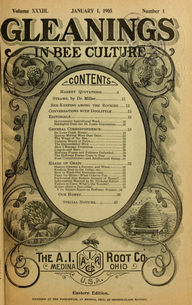
The 1 January 1905 of
Gleanings in Bee Culture carried a story describing
the Wrights' 20 September 1904 flight.
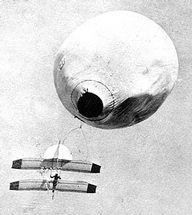
On 18 July 1905, the Montgomery glider was damaged on its
ascent, it failed on the descent and Maloney was killed.
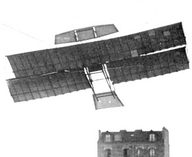
Archdeacon's second glider was never flown by a pilot. It was
towed aloft unmanned and crashed a few moments later
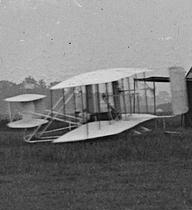
Despite its improvements, the first version of the 1905
Wright Flyer III was still "close coupled" as the previous
Flyers had been. The elevator and rudder were too close to
the wings, creating control problems.
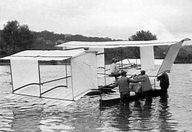
The camber on the Voison-Bleriot float glider was much
deeper than the Voison-Archdeacon machine, making it much
harder to control.
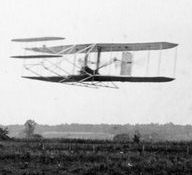
7 September 1905 – After a few mishaps as the Wrights get
used to their new controls, they begin to make uneventful
flights – and safe landings.
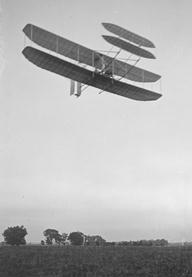
4 October 1905 – The Wrights fly before the media for the
first time since May 1904. |
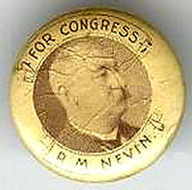
A campaign button for Congressman Robert Nevin.
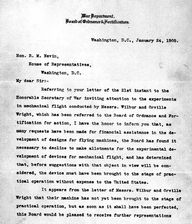
The United States War Department, Board of Ordinance.
rejected the Wright aircraft because it must first be
brought to a "stage of practical operation." This left
future historians to wonder if the War Department ever read
the Wright proposal since the brothers had clearly stated
they had produced an aircraft of "practical use."
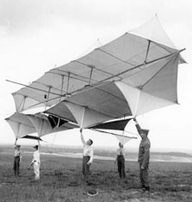
The Cody kite-glider was kited to altitudes of up to 350
feet (107 meters) and soared as far as 740 feet (226 meters) horizontally.
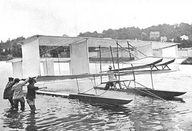
The 1905 Voison-Archdeacon biplane glider, with its forward
elevator and box-kite tail, became a standard configuration
for many European aircraft.
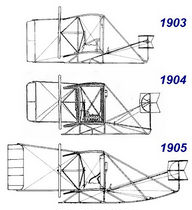
After Orville's crash of 14 July 1905, the Wrights rebuilt
the Flyer III, extending the rudder and elevator out from
the wings. This increased control effectiveness and allowed
the pilot more time for attitude adjustments and
corrections.
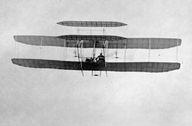
29 September 1905 – After gaining more experience, the
Wrights found they could keep the Flyer aloft till it ran
out of gas.
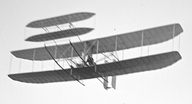
A close-up of Orville Wright flying on 4 October 1905.
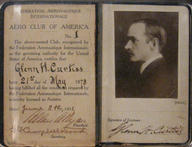
The Fédération Aéronautique Internationale disseminated
information about aviation, kept official records, and set
standards, such as the requirements for a pilot's license. |
|
|
|
|